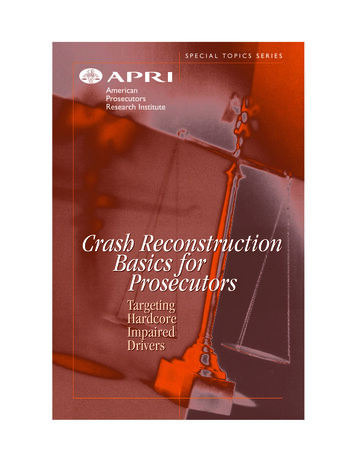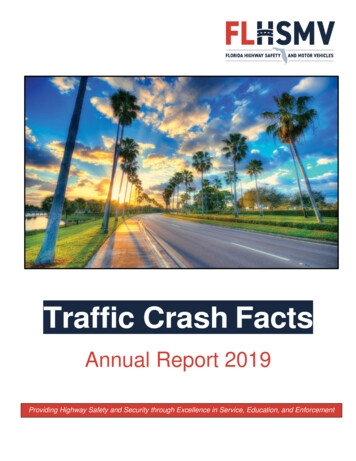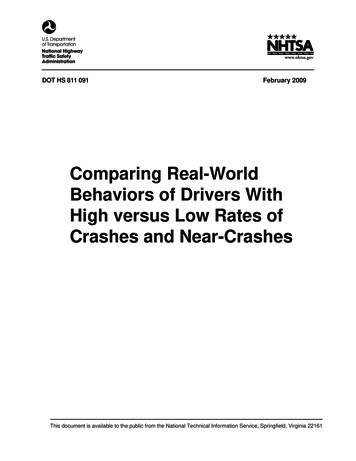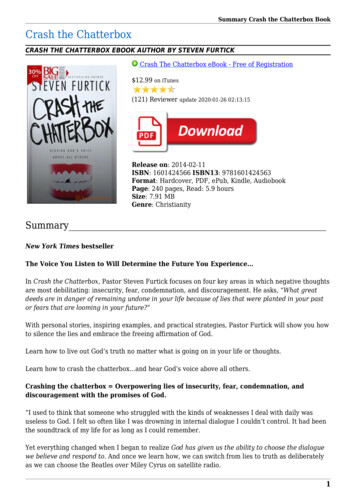
Transcription
1032061 CrashMono cov APRI V3a2/12/0310:58 AMPage 3S P E C I A L TO P I C S S E R I E SAmericanProsecutorsResearch InstituteCrash ReconstructionBasics forProsecutorsTargetingHardcoreImpairedDrivers
1032061 CrashMono cov APRI V3a2/12/0310:58 AMPage 4 2003 by the American Prosecutors Research Institute, the non-profit research, training andtechnical assistance affiliate of the National District Attorneys Association.This publication was produced thanks to a charitable contribution from the Anheuser-BuschFoundation in St. Louis, Missouri.Their encouragement and support in assisting local prosecutors’fight against impaired driving is greatly appreciated. Points of view or opinions expressed arethose of the authors and do not necessarily represent the official position or policies of theAnheuser-Busch Foundation, the National District Attorneys Association, the AmericanProsecutors Research Institute, or the U.S. Department of Transportation.
Crash Reconstruct monoV32/12/0311:05 AMPage 1S P E C I A L TO P I C S S E R I E SCrash ReconstructionBasics h 2003American ProsecutorsResearch Institute
Crash Reconstruct monoV32/12/0311:05 AMPage 2
Crash Reconstruct monoV32/12/03TA B L E11:05 AMOFPage 1CONTENTS3Introduction: Making Tough DecisionsJohn Bobo, Director, APRI’s National Traffic Law Center5Crash Reconstruction BasicsJohn Kwasnoski, Professor Emeritus of Forensic Physics atWestern New England College, Springfield, MA571010111720Evaluating the Officer’s Report of the CrashProof of OperationAnatomy of a CrashReconstruction FundamentalsEnergy AnalysisMomentum AnalysisAirborne Vehicles: Speed in aVaulting MotionSpeed from Yaw MarksTime-distance AnalysisSpeed from “Black Box” RecorderChallenging the Defense’s ExpertAppendix: Minimum speed from skid marks chart21232526331
Crash Reconstruct monoV32/12/0311:05 AMPage 2
Crash Reconstruct monoV32/12/0311:05 AMPage 3INTRODUCTION:MAKING TOUGH DECISIONSProsecutors see hardcore drunk drivers every day in court, often recog-nizing them from many other court appearances. As documented in theTraffic Injury Research Foundation’s 2002 report DWI SystemImprovements for Dealing with Hard Core Drinking Drivers: Prosecution,* theseare defendants familiar with the dark corners and back alleys of the legalsystem, often taking advantage of prosecutors ill-equipped with the technical skills and knowledge needed to successfully prosecute hardcoreoffenders. After all, impaired driving cases are some of the most difficultcases to prove.They involve scientific evidence, expert testimony, complex legal issues and jurors who typically identify with offenders.Thesecases require nothing less than the highest level of advocacy skills.One of the more difficult challenges for prosecutors is evaluating fatalmotor vehicle crashes. Prosecutors already know what national datareflects. Roughly 40 percent of every fatal crash report that prosecutorsassess will involve impaired driving. And, grieving families, law enforcement officers and reconstructionists all look to the prosecutor’s office todecide the legal ramifications of what happened: Was this an accident or avehicular homicide? Was this civil negligence or criminal recklessness? Was a crimeeven committed? While they wait for the decision, many prosecutors areleft scratching their heads trying to make sense out of a reconstructionist’s report. Not only are they trying to answer, What happened? but prosecutors want to know If this is what happened, how do I prove it? Toughdecisions to make, and to make those decisions, prosecutors need to bearmed with the best knowledge available.This publication serves as a primer for prosecutors on the basic science,investigative techniques and what questions to ask.Thanks to ProfessorJohn Kwasnoski, author and nationally-recognized expert on crashreconstruction, much of the mystery, myth and mathematical phobiassurrounding this material will be dispelled.* For the complete text of the report, visit www.trafficinjuryresearch.com3
Crash Reconstruct monoV32/12/0311:05 AMPage 4CRASH RECONSTRUCTION BASICSFORPROSECUTORSNever before has material like this been assembled for prosecutors, andour hope is this publication will be used by prosecutors to strengtheninvestigations, learn the truth and honor their calling to serve justice.John BoboDirector, National Traffic Law CenterAmerican Prosecutors Research InstituteMarch 20034A M E R I C A N P RO S E C U TO R S R E S E A R C H I N S T I T U T E
Crash Reconstruct monoV32/12/0311:05 AMPage 5CRASH RECONSTRUCTIONBASICSBy John KwasnoskiProfessor Emeritus of Forensic PhysicsWestern New England College,Springfield, MA,Evaluating the Officer’s Report of the CrashAfter a crash, the prosecutor receives a written police report, and inmany cases, a part of that report focuses on the reconstruction of thecrash - the pre-impact motion of the vehicle(s), vehicle speed, etc. andthe cause of the crash. At this early stage in the case after receiving thereport, the prosecutor can strengthen the investigation by criticallyassessing the reconstruction and playing the role of the devil’s advocate. At this point, challenging questions must be asked, and in someinstances, additional investigation must be done to close any gaps inthe state’s case.The prosecutor should be particularly sensitive to issues affecting thecredibility of the potential police witness at trial.The prosecutor shouldlook for some of the following in the officer’s report of the crash:1. Have the vehicles involved in the crash been secured? How werethey transported? Are they now covered or secured indoors? Ifoperator identification becomes an issue, certain types of forensicevidence may be compromised by weather.Note: a vehicle should never be released from police control unlessthe prosecutor knows that the defense has no further use for thevehicle and will not want to conduct any further inspection of thevehicle.2. Are the locations of witnesses known and documented? The credibility and accuracy of a prosecution witness may be challenged bydefense assertions regarding the perspective of the witness.5
Crash Reconstruct monoV32/12/0311:05 AMPage 6CRASH RECONSTRUCTION BASICS3. Have all aspects of the scene been vehicle(s) at final rest position evidence of the area of impact witness perspectives collision debris distributionFORPROSECUTORSphotographed: operator’s view approaching crash road evidence (and close-ups) interiors of the vehicles vehicle damage4. Were the vehicles, bodies, or evidence moved prior to being documented?5. Does the report include a scale drawing?6. Was the drag factor of the road measured at the scene? This singlepiece of evidence is often the focus of the entire defense attack onthe case since it is an integral part of many methods for estimatingvehicle speed.7. Did the investigating officer “walk the scene” to look for road defectsor evidence that the road may have caused the collision? While thisactivity is usually part of an investigation, the police report oftendoes not document it, and issues may surface later in the case. Byincluding this in the report, officers show that they looked forpotential exculpatory evidence as part of the routine course of theinvestigation, which dispels any claims of bias.8. Has the investigator checked for recalls on all of the vehicles involvedin the crash? This issue opens the door for claims of vehicle malfunction or defect as the cause of the crash.The prosecutor should neverbe blindsided by having this issue raised after a vehicle has beenreleased or a mechanical inspection can no longer be done.9. Have the event data recorders (EDRs) or “black boxes” beenremoved from the vehicles and placed into evidence? The EDRs maycontain information such as the speed, use of brakes, deployment ofthe air bags, seat belt use, engine RPM, etc. for as much as five seconds before the crash.The EDR should be secured in anticipation ofbeing able to read the computer memory at a later time. Some officers have training in how to down load the data; other agencies relyon assistance from the dealerships or car manufacturing company.(Also see pages 25 and 26.)10. Has the clothing of all the occupants in the defendant’s vehicle beensecured? This may help in debunking the claims that someone elsewas driving.6A M E R I C A N P RO S E C U TO R S R E S E A R C H I N S T I T U T E
Crash Reconstruct monoV32/12/0311:05 AMPage 7CRASH RECONSTRUCTION BASICS11. Have the defendant’s injuries and entire body been photographedand documented? Such injuries may help to establish that the defendant was the operator at the time of the crash.12. Can the medical responders or hospital personnel who treated thedefendant be identified?13. Has road evidence been completely documented, including measurements and photographs clearly showing the appearance of tire marks?A common defense attack is to interpret tire marks differently toreach a different conclusion about vehicle speed. If the credibility ofthe state’s entire case comes down to the observations the officer(s)made at the scene, the evidence should be documented as completely as possible. Debris location can be crucial in a specific instance, yetdebris is often less than completely documented.14. Are there any visibility issues, such as weather, ambient lighting, roadtopography, etc. that may affect the defendant’s ability to avoid thecollision? This can best be documented during the initial investigation, and may be compromised to some extent by trying to recreatethe conditions at a later date.Search for Gaps Through VisualizationLooking at the report with a critical eye, it is important for prosecutorsto visualize the crash from the information in the report alone. By making a conscious image of the crash, second by second, the prosecutor willimmediately see gaps in the paperwork. Using some model cars andrecreating the vehicle motions can clarify additional investigation thatmay be needed - gaps in the state’s case may suggest reasonable doubtlater. A few extra minutes spent early in the evaluation of the case cansave the prosecutor hours of work later, and strengthen the case.Proof of OperationProsecutors often make the mistake of taking for granted proof of operation. After all, this element of the offense hardly seems disputable —especially after a defendant made an admission of operation and the prosecution’s reconstruction is completed. But, when the speed calculations aresolid as well as reconstruction proof of criminal negligence, a defendant’sonly defense may be that he was not the operator.This defense often sur-7
Crash Reconstruct monoV32/12/0311:05 AMPage 8CRASH RECONSTRUCTION BASICSFORPROSECUTORSfaces after the investigation has been closed and the defendant’s vehiclehas been released from police control. Initially, officers should try to confirm that the defendant was the operator by documenting: Observations of eye witnesses who saw that the defendant was operating the vehicle, either pre-impact, post-impact or both. Testimony of medical or emergency personnel. Statements of hospital personnel who may have heard the defendantmake an admission of operation. Also, check defendant’s medicalrecords for admissions. Forensic evidence of operation: fingerprints, hair, blood, etc. Matching damage to the interior of the vehicle to defendant’s injuries. Evidence from occupant protection devices (seat belts, air bags). Elimination proof of other occupants. Evidence of contact with glass in the vehicle (either lacerations fromwindshield glass or “dicing” from tempered side windows)Head strike evidence, called a “spiderweb” fracture, was made in this vehicle by the driver. Sudden rotation ofthe car caused by impact with a tractor-trailer spun the vehicle so quicklythat the driver was thrown acrossthe car before hitting the windshield.Without reconstructing the crash,hair evidence in the fractured glassmay have suggested the head striketo be by the passenger.If the operator identification becomes an issue, the following questionsmay determine whether a reconstructionist or “occupant kinematicsexpert” can be of assistance:1. Is the vehicle secured and in the control of the state?2. Are the defendant’s clothing and shoes secured?3. Is the clothing of an operator alleged by the defense secured?4. Are there photographs of the vehicle interior?5. Are there complete photographs of the defendant’s injuries, includingareas of the body that are not bruised or injured?6. Are there autopsy or other photographs of the alleged operator’sinjuries?8A M E R I C A N P RO S E C U TO R S R E S E A R C H I N S T I T U T E
Crash Reconstruct monoV32/12/0311:05 AMPage 9CRASH RECONSTRUCTION BASICSIn anticipation of such defenses the prosecutor may want to establishpolicies with individual departments and with area hospitals to ensurethat valuable evidence is collected as a routine part of the investigation ofcrashes. Medical records, coroner’s reports and autopsy reports may provide the basis for an expert to reach an opinion as to who was operatingthe vehicle at the time of the crash: “pattern injury” on chest fromsteering wheel head contact with A-pillar(roof supports) blood smears on interiorof vehicle fingerprints on steering wheel,key, control levers, light switch,rear-view mirror and/or gear shift eye witnesses before or after crash blood spatter on driver’s sideof vehicle knee injury from contactwith dash seat belt marks or abrasionsconsistent with belt use fabric fusion onto seat belt or dash forensics on deployed air bag abrasion from contact withhead liner forensics from windshield spiderweb fracture seat position pedal impression on bottomof shoe shoe transfer onto console (left-toright ejection) inability to operatemanual transmission clothing fibers in broken partsof dash, controls injuries to ribs consistent withstriking door panel lacerations on face fromwindshield contact dicing or multiple small cuts fromside glass implosion teeth impressions on vinyldash material damage to rear-view mirror fromhead impact “pattern injury “on leg fromshift lever “pattern injury” on leg fromdoor handle personal belongings under seat hair embedded in windshield gas purchase receipts orconvenience store video clothing fusion onto seat damage to brake pedal consistentwith leg injuryNote: Failure to find the indicators above should not be interpreted asproof that a particular person was not operating the vehicle. In some cir-9
Crash Reconstruct monoV32/12/0311:05 AMPage 10CRASH RECONSTRUCTION BASICSFORPROSECUTORScumstances, evidence may not have been documented by police or identified by other witnesses. Or, the event did not generate evidence thatgoes to proof of operation.The Anatomy of a CrashA crash occurs in three chronological phases - pre-impact, impact(engagement), and post-impact.The basic events in the crash are listedbelow; not every crash has all of these events, and the events may occurin a different order than stated:1. Point of first possible perception - the time and place where the dangerousor hazardous situation could first have been perceived.2. Point of actual perception - the time and place where the first perceptionof danger occurs.This point may be difficult to determine with anycertainty.3. Point of no escape - the point and time after which the collision cannotbe avoided.The relationship of the point of no escape to the point offirst possible perception must be determined to answer a key question:could the crash have been avoided?4. Point of operator action - the point and time where the operator initiatedsome action such as braking or steering to try to avoid the collision.Immediately prior to this point is the perception-reaction time of theoperator, which may be a hotly disputed point in the case.5. Point of initial engagement - the point where contact is first made duringthe crash, including the identification of the “point of impact” (POI)or “area of impact” (AOI). In pedestrian and crossing the center linecases, the POI is often disputed.This is especially true in pedestriancases where the POI is used to estimate vehicle speed.6. Final rest position (FRP) - the point where a vehicle comes to rest.TheFRP, and how the vehicle got to the FRP (skidding, rolling, combination of the two) constitute what is called the post-impact trajectory ofthe vehicle.Reconstruction FundamentalsThe reconstructionist’s choice of methodology may be governed by thenature and completeness of the evidence at a particular crash scene.What10A M E R I C A N P RO S E C U TO R S R E S E A R C H I N S T I T U T E
Crash Reconstruct monoV32/12/0311:05 AMPage 11CRASH RECONSTRUCTION BASICSfollows is a concise overview of the various methodologies with particular emphasis on potential defense attacks on the reconstruction.Energy AnalysisThe pre-impact motion of a vehicle is characterized by what is called“kinetic energy” or motion energy, which is a mathematical descriptioninvolving the vehicle’s speed and weight. As a collision commences, thevehicle’s kinetic energy and speed are reduced by energy lost to the road surface; energy lost during erratic motion and/or side-slipping; energy resulting in vehicle damage (and other vehicles or objects); energy transferred to property such as utility poles, fences, walls.When the vehicle reaches its FRP, it has zero kinetic energy.The energymethod of reconstructing the pre-impact speed of a vehicle includes isolating each event and identifying its energy loss, quantifying the energyloss by the equivalent speed needed to produce each loss, and thenadding the equivalent speeds of all the events together using what iscalled “the combined speeds equation” to find the pre-impact vehiclespeed.This is usually a minimum speed since some of the energy cannotbe quantified.Energy Analysis 1: Speed from Friction Marks Made by TiresA common crash event involves losing energy (and speed) by transferringit to the road and causing a visible tire mark (skid, ABS scuff, etc.).Theequivalent speed of such an event depends on road friction (drag factor),distance over which deceleration occurred, and the degree of braking,called braking efficiency (BE).These measured quantities can be used tocalculate a minimum speed needed to make the tire marks by using thespeed from skid marks equation:S (mph) ( 30 (f)(d)(BE) )This equation has been validated in numerous published studies1 and isincluded in every basic crash reconstruction text. Some facts about thespeed from skid marks equation include: No vehicle specific information (vehicle make, model, weight, etc.) is11
Crash Reconstruct monoV32/12/0311:05 AMPage 12CRASH RECONSTRUCTION BASICSFORPROSECUTORSneeded since the equation is derived from the basic physics of the frictional interaction of the tires with the road. Reasonable changes in the data produce insignificant changes in calculated speeds; the result is not sensitive to uncertainties in measured dataused as input into the equation. The equation is widely accepted and has been judicially noticed. Since tire marks start after braking commences, the equation producesan underestimate of speed.Measuring with the Drag SledThe drag factor of a road surface can be measured with either a drag sledor accelerometer attached to a vehicle. Both of these devices producemeasurements of equivalent accuracy, if used correctly, as shown in published tests.2 The drag sled should not be used to measure the drag factoron wet roads where the weight of the car would squeegee the water outfrom under the tire tread.This is impossible to duplicate with a drag sled.A drag sled should also not be used on grass, as it cannot accurately produce the same friction as a full-sized vehicle, whose weight furrows thetires into the ground when it travels.Officer pulling a drag sled and readingthe pull force on the calibrated springscale. A drag sled is basically a weightedsegment of a tire, and may have manydifferent configurations. (Photo: courtesy of Ludlow, MA Police Department).The sled is pulled in the same direction as the vehicle motion, as close aspossible to the actual tire marks, and the pull scale is read when the pullbecomes smooth and free from any jerking motion. Usually multiplemeasurements are made over the length of the entire tire mark (tire markpattern) to eliminate the suggestion of significant differences within thetire mark pattern, and investigators may use the lowest measured valuefor their calculations.The method for determining the drag factor isshown as follows:12A M E R I C A N P RO S E C U TO R S R E S E A R C H I N S T I T U T E
Crash Reconstruct monoV32/12/0311:05 AMPage 13CRASH RECONSTRUCTION BASICSpulling force road friction 28 lbsThe method for determining thedrag factor value using the pullforce and the sled weight.Friction forceweight of sled 40 lbs(pressure tire against road)drag factor friction force / weight 28 lbs / 40 lbs .70A table of “typical” values for the drag factor is given below. Somedefense attorneys may misstate that this is the only possible range of values,but actual roads often fall outside this range because of specific composition of the road surface material.dry asphalt, cement.60 - .80wet asphalt, cement.45 - .70ice, loose snow.10 - .25packed snow.30 - .55Source:Traffic Accident Reconstruction,Vol. 2, Fricke.Common Defense AttacksSince the drag factor is an important part of the reconstruction methodology, defense attacks attempt to lower the value measured at the sceneby investigators. Some of the more common attacks include:CLAIM: During measurement, drag sled bounce produced an unacceptable uncertainty in the measurement.REALITY:The drag sled scale is not read until the pull is smooth.CLAIM: Multiple measurements were not made to reveal variations overthe length of the vehicle motion.REALITY:Without obvious visible differences in the road surface suchvariations usually are insignificant, but multiple measurements are alwaysthe best protection against such a claim.13
Crash Reconstruct monoV32/12/0311:05 AMPage 14CRASH RECONSTRUCTION BASICSFORPROSECUTORSCLAIM: Drag sleds are not acceptable since accelerometers have beendeveloped.REALITY: Drag sleds produce the same measured values as accelerometers as has been documented in side-by-side testing.3CLAIM: Measured drag factor falls outside published ranges.REALITY:This is a misinterpretation of such tables which are notintended to imply strict limits on possible drag factor values.4CLAIM: Drag factor is velocity-dependent and decreases at higher vehicle speeds. In other words, the defense is asserting that the officer measured the drag factor at a low speed and failed to reduce the drag factorwhen used in equations that yield higher speeds.REALITY: Drag factor values at low speeds are the same as values athigh speeds on dry roads, as shown by recent tests done by NY StatePolice and this author. Caveat: Many defense attorneys use Fricke’s tableon the previous page to imply that drag factors depend on speed, butFricke’s table is not supported by actual field measurements.CLAIM: The scale used to pull the sled was not calibrated and isinaccurate.REALITY: Maybe. Police should periodically have their scales checkedagainst local weights & measures or in some other way to certify theiraccuracy.The Truth About BrakingThe length of a braking action is determined by the measurements of thetire marks on the roadway.These marks should be photographed andtheir specific appearance documented to avoid misinterpretation later. Agood practice is to have several officers confirm the nature of the tiremark evidence, including a complete photographic record. Using a polarizing filter to reduce road glare and shooting from several angles mayimprove the quality of tire mark photographs. Braking efficiency is determined by weight distribution and the contribution of each wheel to thefrictional slowing of the vehicle.This determination may involvemechanical inspection, tire inspection for evidence of braking or scuffing,and matching the vehicle’s tires to tire marks on the road through rib14A M E R I C A N P RO S E C U TO R S R E S E A R C H I N S T I T U T E
Crash Reconstruct monoV32/12/0311:05 AMPage 15CRASH RECONSTRUCTION BASICSpattern, track width, etc. Tire pressure, tire construction, ambient temperature, and tread depth are not significant factors on dry road surfaces.Energy Analysis 2: Speed from Vehicle Damage/Crush AnalysisThe speed (energy) required to cause permanent deformation of a vehicle can be analyzed by referring to the results of staged automobile crashtests. Manufacturers routinely conduct controlled tests to evaluate the“stiffness” of vehicles under various collision configurations (front, side,rear).These tests yield what are called stiffness constants, numbers that willdescribe mathematically how a vehicle’s impact speed is related to theresulting damage. Databases of these characteristics allow the reconstructionist to determine the equivalent speed needed to cause damage if thecrush profile or damage dimensions are measured according to a strictmeasurement protocol.5 The calculation can be done by hand using analgorithm developed as part of the EDCRASH computer software,6 or itcan be done with any number of computer software packages available toreconstructionists.The calculation of crush energy (and equivalent speed)is done by modeling the damage area into crush zones and then determining the energy needed to cause the damage in each zone.The intrusioninto each zone, called the crush depth, is measured by a strict protocol thatis consistent with the measurements made during the original stagedcrash tests, as shown below. Finally, the zones are totaled, and an equivalent speed to create all the damage is determined. Due to lack of training, some law enforcement reconstructionists do not use crush analysis,but the method is generally accepted and should not be overlooked.C1C2C3C4Measurements of the crush resulting from a frontal impact. Depth ofcrush in each zone is measuredfrom the undamaged dimension ofthe vehicle (dashed line).C1 31" C2 27" C3 18" C4 12"Energy Analysis 3: Speed From Utility Pole ImpactImpact speed of a vehicle that strikes a utility pole may be possible todetermine either from the damage to the car or a fracture of the pole.15
Crash Reconstruct monoV32/12/0311:05 AMPage 16CRASH RECONSTRUCTION BASICSFORPROSECUTORSResearch done by universities and utility companies on wooden andmetal poles has resulted in a data base that relates pole failure (fracture)to vehicle speed.7 Research on collisions into utility poles has resulted inempirical equations that relate intrusion depth to impact speed.8 Theseempirical equations can be compared to determine a relatively narrowrange of possible impact speeds that would have resulted in the observeddamage to the vehicle.As the basis for a separate speed determination, the damage to a pole shouldbe photographed and measured (height above ground, pole diameter atdamage point, etc), and the age of a wooden utility pole should be determined. It might also be necessary to secure a sample of the pole itself in acase where a certain type of analysis is done on the fractured or failed pole.In some cases, an impact into a tree can be mathematically analyzed usingthe utility pole equations, and this involves careful study of the nature of theimpact to be sure it fits the criteria of the utility pole research.Speed in a Multiple Event CollisionOnce the individual events of the collision have been analyzed andequivalent speeds determined for each event, the speeds are totaled usingthe combined speeds equation, which is based on adding together theequivalent speeds of the events:S ( S12 S22 S32 . )The reconstructionist may not include all the events.There may be a lackof empirical evidence, testing, etc. to analyze a specific event like knocking down a mailbox, running through a chain-link fence, jumping a curb,uprooting a small shrub, etc. Rather than make an assumption necessary,the reconstructionist simply acknowledges that the event has been leftout of the total; therefore, the combined speeds calculation is a minimumspeed estimate.It is always better to avoid making assumptions.The credibility of the restof the reconstruction may be compromised, opening up a defense attackthat can distract from the case.The best practice is to avoid making16A M E R I C A N P RO S E C U TO R S R E S E A R C H I N S T I T U T E
Crash Reconstruct monoV32/12/0311:05 AMPage 17CRASH RECONSTRUCTION BASICSunfounded assumptions about those events and sticking to a minimumspeed estimate.The combined speeds equation is part of basic reconstruction texts and is widely accepted. Officers may refer to this method asthe conservation of energy method because they evaluate the energy of eachevent and add them together.Momentum AnalysisAnother method used to determine pre-impact speed is based upon theprinciple of conservation of momentum. Every vehicle in motion has aproperty called linear momentum, which may be defined by multiplyingthe vehicle weight by its speed.The concept of momentum is complicatedby the fact that the momentum also has a direction - the momentum of acar moving eastbound may be described as positive, while using that frameof reference, the momentum of a westbound car would be negative. Sincethe vehicles often move in paths that are not parallel to one another, thelinear momentum analysis must employ the concepts of trigonometry tomathematically describe the motions.This generates an abundance oftrigonometry symbols, angles, a zero reference direction and long calculations that may be well beyond the ability of most jurors to understand.Momentum Analysis in a NutshellThere are eight numbers (called variables) in the general momentumequa
5Crash Reconstruction Basics John Kwasnoski,Professor Emeritus of Forensic Physics at Western New England College,Springfield,MA 5Evaluating the Officer's Report of the Crash 7Proof of Operation 10 Anatomy of a Crash 10 Reconstruction Fundamentals 11 Energy Analysis 17 Momentum Analysis 20 Airborne Vehicles:Speed in a Vaulting Motion










